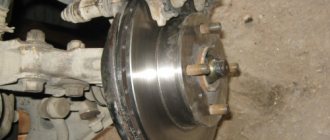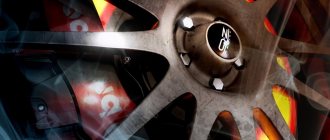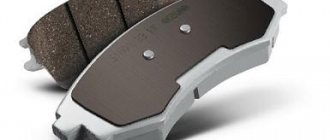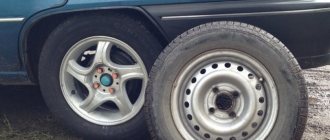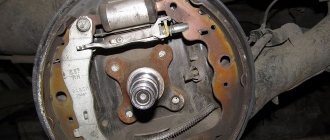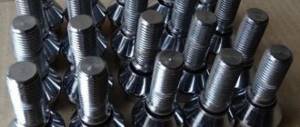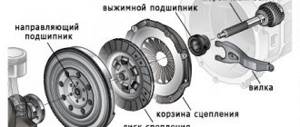What types of brake pads are there?
The degree of wear of a disc or drum is greatly influenced not only by driving style and road conditions. The surface of the friction linings of the brake pads, perhaps, affects the wear of the system most of all. Brake pads are divided into several types based on the material used to make the friction lining:
- metallized;
- synthetic;
- ceramic;
- asbestos-containing.
Friction linings containing asbestos are not currently used, since the use of this material is prohibited. Harmful hurts. Therefore, it is being replaced by other synthetic materials with similar properties. The main thing you need from a brake pad is to withstand wear and temperature. The pad can heat up to 600 degrees, and this affects both disc wear and friction lining wear.
The influence of friction linings on discs and drums
But now we are primarily interested in the effect of the pads on the condition of the brake disc. Soft synthetic semi-metallic brake pads wear out the brake disc the least, but are not as effective in braking. They make little noise, but during operation they create quite a lot of dust. The resource of soft pads is small, and they are designed for a quiet and comfortable ride. Then they don’t wear off so quickly.
Stiffer brake pads are designed for aggressive riding styles and are harder than synthetic pads. As a rule, the metal content in them is 30-45%. Copper chips, graphite, and thin steel fibers can be used as filler. Metallized pads are noisy in operation, but they are very tenacious and do not wear out as quickly as synthetic pads with a low metal content. But they wear out the brake disc the most, and sometimes they can overheat it. Here it is not far from warping of the surface, which not every grinding and grooving will correct.
On the machine
Now there are special machines, and the work is done directly on the car. This equipment is quite expensive (at least 100,000 rubles), but still, we will tell you about some of the features of its use. After all, if you really want to, you can find an option to rent such equipment.
The easiest way to use modular installations in a small garage. They do not take up much space and are easy to transport. When installing equipment, be sure to check the requirements for the location of the vehicle; it is especially important to consider the height of the hub. It is also advisable to take into account the size of the required groove. These parameters are set to the machine control unit. Further work occurs without human intervention.
Groove with removal
.
For this work you will need to disassemble the wheel, but this method is considered the most effective. This is done on a lathe. You should choose a machine model; it should have the function of grooving on both sides simultaneously. Otherwise, the balancing of the disk is disrupted, which will lead to its beating during movement. Afterwards the mirror is sanded with sandpaper. Conclusion . Problems with brakes on cars are not that uncommon. This is due to the active operation of this system. Damage often occurs on the disk mirror. It is advisable to eliminate them immediately. But that’s not all, after you have grooved the brake discs without removing them yourself, you should check the remaining elements of the system. Damage is often caused by worn pads or improperly functioning caliper cylinders. Correct all identified faults.
Methods and tools for detecting disk failures
The deterioration of the brake system is visible to the naked eye and no special stands are needed here. Signs of wear on brake system consumables are simple:
- Indistinct response to the brake pedal.
- Increased noise, creaking and squealing of brake pads and discs.
- Vibrations and beats when braking.
- Brakes overheat under normal conditions.
This is easy to check visually, without even disassembling the brake mechanism. It is enough to measure the level of wear on the pads and discs or drums, and the situation will become clearer. The manufacturer indicates the permissible thickness of the brake disc at the end. But, as a rule, you don’t have to look for the inscription, but start from the value of 10 +- 2 mm. The thickness of the linings for each car is allowed to be different, and here it is better to scroll through the Murzilka for the car. But there will be no news there either. The average permissible thickness of the friction lining is at least 2-3 mm.
Brake disc boring machine and other work tools
Replacing brake discs with new ones is not a cheap pleasure, so in some cases you can restore them yourself. Let's look at how brake discs are bored without removal, and what is needed for this. However, before you start grinding directly, you need to find out whether it is necessary, or perhaps in this case the discs only need to be replaced.
For this purpose, we carry out a visual inspection and determine the extent of damage. The fact is that the manufacturer sets the minimum possible thickness of the brake discs; this value is usually indicated in the operating instructions . Therefore, if the grooves are too deep and the surface is severely deformed, then in this case we can only talk about replacement.
But, if the part is subject to restoration, then you should get the following tools: a jack, a hammer, a wrench (for removing a wheel), and you will also need a special machine for boring brake discs. The grooving technology consists of the following stages. First, you need to dismantle the wheel, at the next stage the brake pad is removed, and then you need to attach a special adapter to the car hub. The machine support for grooving is inserted into this adapter.
Why grind brake discs?
Now you can put the caliper and micrometer aside and simply run your fingers along the surface of the brake disc. It is all pitted with wear and tear. The deeper the grooves, the more the disc eats up the pad. And the harder the friction lining, the greater the likelihood of ruts appearing. Now let's pay attention to the shoulder that has formed as the disc wears out. It is sharp and sometimes you can cut your finger on it. What about the brake linings?
This is why brake discs are ground. And after grooving, they also grind it in order to bring the working surface to the ideal condition as much as possible. Thus, after grooving, the disc becomes even and smooth and will last for quite a long time. But the groove is not omnipotent, and if the disk has suffered from overheating, no one will sharpen it. Firstly, the structure of the metal is no longer the same, and secondly, eliminating the disc runout with a groove is a rather dubious method.
Do-it-yourself brake disc grooving
The surface of the brake discs wears out when braking. This often happens unevenly. One of the ways, in case of defects, to extend their performance with your own hands, is to re-groove the brake discs.
To carry out this procedure efficiently, it is worth understanding what signs exist that indicate defects in the brake discs. And also: why do you need a groove, how can you do it yourself, types and technology for processing these spare parts, machines and equipment necessary for the work.
Defect diagnostics
It is necessary to recognize the appearance of defects on these components of the brake system in a timely manner, because the safety of the car owner may directly depend on this.
Grooving or boring the front or rear brake discs may be necessary when the following symptoms appear when the vehicle is braking:
- Vibration or palpable vibration in the brake pedal or steering wheel.
- When you touch the wheel rims, you feel their significant heating.
- The braking distance of the car has increased more than usual.
- A visual inspection reveals scuffs, cracks, a shoulder, deep grooves and significant rust on the working surface of the brake discs.
Why is such a procedure necessary?
Due to deformation, the working part of the brake discs loses its original shape, which reduces its contact area with the pads.
Also, as a result of frequent and sharp braking of the car, their metal heats up and if water or snow gets on it, scale forms. Another defect is the appearance of a layer of rust on their working layer. Rust occurs when a machine is not used for a long time and is stored outdoors or in a damp room.
All this entails an increase in the period of time required to completely stop the car.
After measuring the thickness of the brake discs, if it is significantly greater than the minimum, you can do their own grooving, which will help:
- Eliminate vibration and wobble.
- Increase the efficiency and reliability of brakes.
- Extend service life and save on purchasing new disks.
Types and processing technology
To eliminate defects on a disk with your own hands, there are two processing technologies. The first of them is boring, which is produced to increase the diameter of its working surface. This procedure helps to get rid of the bead that appears when the friction linings of the pads do not cover the entire area of the disc during braking.
The second processing technology is grooving, which is done to eliminate surface defects: the resulting layer of rust or scale, uneven wear in the form of deep grooves. In this case, it is necessary to take into account the size of the layer to be removed based on the minimum permissible thickness recommended for a given brand of brake discs.
In the recent past, there was only one way to eliminate defects with your own hands on these brake elements - processing them on a stationary lathe.
To do this, they had to be removed from the car first. In this case, it was very difficult to comply with the necessary balancing parameters when eliminating defects. But there were specialists who dealt with this - like those in this video.
Now there are technologies and special machines that allow you to do this without removing the front and rear discs from the car.
With such equipment it is very easy to maintain the necessary balancing and the required thickness of the working surface, because on it these parameters are set both manually and automatically. This can be seen more clearly in the attached videos.
Equipment
In general, eliminating defects on removed front and rear brake discs on a lathe is a half-measure. After all, it is very difficult to accurately center and restore the geometry of a given part by eye. Therefore, it is better to do the grooving without removing the discs from the car, using special equipment. After all, such a machine has special sensors that allow you to control the degree of their roughness and runout on discs that have not been removed.
In addition, the characteristics of such equipment make it possible to restore the geometry by taking into account the real axis during hub rotation and remove defects: significant roughness and small cracks, regardless of the diameter of the machine disk. Also, their big advantage is the adjustable spindle rotation speed, which makes it possible to achieve an almost mirror-like cleanliness of the surface being machined.
And the ability to process a part without removing it from both sides using two cutters significantly reduces the time for eliminating defects.
Defect elimination process
The wheels and caliper are removed from the car. A special adapter is attached to the hub, allowing you to remove all the necessary parameters: thickness, degree of wear, surface roughness. Also, if the equipment provides a function for rotating the hub, then special fasteners are attached to it. Then the engine of this equipment is turned on, or if it is not provided, the car starts and the gear is engaged. After the hub begins to rotate, the necessary parameters are measured. Having understood all the data obtained, you can begin to eliminate defects using special cutters that are installed on the sides of the surface being processed.
Having aligned the cutters, the engine starts again (the gear is switched on or the corresponding equipment mechanism is started) and the grooving itself occurs. Typically, two or three passes of the cutter are required to complete a surface finish.
After completing the procedure, it is necessary to install new pads. It is also recommended to brake carefully for the first few hundred kilometers to grind in the working surfaces of the disc and pads.
The article first appeared on AutoRemont2.ru
Similar
Grooving brake discs - how, with what and where
Grinding brake discs without removing them yourself is only possible if you have a Dutch MAD disc processing machine lying around in your garage. But this is unlikely, because it costs about 4 thousand euros. Not every service station can afford such luxury. But if a station offers such a service, that’s great. Because turning discs without dismantling saves a lot of time, turning is carried out at the highest quality level, and after turning, the stand also does grinding. This is what it looks like at work. Nice to watch.
You can go another way. Remove the brake discs and take them to a familiar turner. But where is the guarantee that the machine is not pre-reform and that it will perfectly grind the surface without a hint of beating? There is no such guarantee. Therefore, if it is possible to sharpen a disc without removing it on a special stand, do not be greedy. A new disk costs a hundred times more, and it’s simply stupid to measure security in money.
The more attentive we are to the brake mechanisms, the longer and more efficiently they will last. Therefore, maintain your brakes on time and efficiently, and your car will always stop where you want it, and not where it doesn’t. Slow down in front of potholes, and good luck to everyone!
Diagnosing brake discs
At certain indicators in the operation of the brakes, when their efficiency noticeably decreases, there are two options for solving the issue of improving the quality of the braking system: replacing the brake discs or regrooving the brake discs.
We will not rush to buy new brake discs - it’s not a cheap pleasure, especially since today there is a completely accessible and inexpensive service - regrowing brake discs without removing them.
More recently, in order to sharpen brake discs, you needed a lathe and dismantling the brake system, but modern equipment for turning brake discs allows you to limit yourself to only removing the wheel.
Without naming the manufacturing companies, let’s just say that any modern stand for grooving brake discs, which is equipped in car services, allows you to eliminate all the side effects of intensive use of the brakes.
The machine for turning brake discs eliminates disc deformation, removes mechanical damage to the working surface in the form of depressions, grooves, etc.
The next step, after grooving, is grinding the brake discs. Why is this necessary? And in order to reduce the break-in period of new brake pads, it is recommended to install them after the process of grooving the brake disc.
